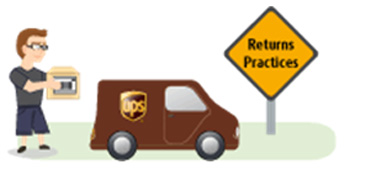Holste Says: |
 |
| Frequent errors, for whatever reason, have the potential to negatively impact customer relations and the company's bottom-line. |
|
What Do You Say?
|
|
|
|
Previous Columns by
Cliff Holste |
|
|
We have all seen the TV commercial where a lady who ordered a pair of red high-heals received a black pair instead. She was not happy! However, after a quick and easy returns process, she was delighted to receive the red pair and was “happy, happy, happy”.
 Depending on the company’s returns policy and practices, for many retailers returns are considered to be a consequence of errors. That is to say some combination of customer ordering error, a supply chain error, and/or order-fulfillment error. Frequent errors, for whatever reason, have the potential to negatively impact customer relations and the company’s bottom-line. Depending on the company’s returns policy and practices, for many retailers returns are considered to be a consequence of errors. That is to say some combination of customer ordering error, a supply chain error, and/or order-fulfillment error. Frequent errors, for whatever reason, have the potential to negatively impact customer relations and the company’s bottom-line.
Research conducted by Voxware, a leading provider of voice solutions, presents a clear picture of how order fulfillment errors and the resulting returns process, is perceived by the customer. Highlights from the survey, which collected responses from 500 consumers, include:
• |
54% of respondents stated that the reason for returning an item purchased online or by phone is because the item is the incorrect size or color.
|
• |
97% of respondents stated that the returns process is important to their future intentions to shop with a retailer.
|
• |
73% of respondents who receive an incorrect item after already returning it once stated that they are much less likely to shop with that retailer online or by phone again for future purchases.
|
• |
45% of respondents who have experienced continuous returns process issues with particular retailers stated that they have limited shopping with that retailer altogether (both online and in-store).
|
• |
26% of respondents expect the correct item to be shipped to them within one to two days after returning the incorrect item.
|
“This research proves that the majority of the time, consumers return products due to retailer error,” states Keith Philips, President and CEO, Voxware. Keith goes on to say, “Mistakes in the supply chain are happening all too frequently, which not only increase distribution costs, but also severely impact customer satisfaction, customer loyalty, and ultimately bottom lines. Online shopping and consumer expectations will only continue to increase. No question, the time for retailers to optimize their warehouses with wearable technology like voice software is now. Hands-free voice software has proven to significantly reduce warehouse picking errors, so retailers can readily get the right product to the right person and keep those loyal customers happy.”
The following includes the full results of the Voxware research:
|